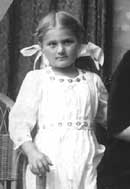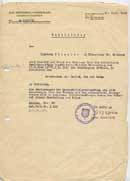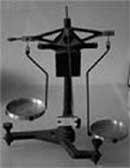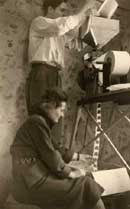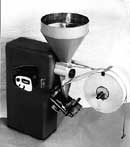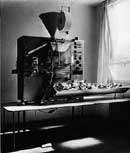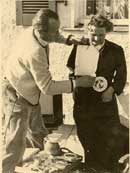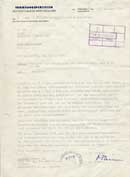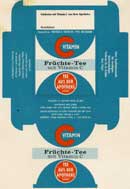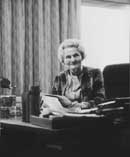History
1949:
Foundation of the company in Kressbronn at Lake Constance under the name "Ingeborg Häußler Kressbronn". On September 19, the former state of Württemberg-Hohenzollern grants permission for the wholesale trade in tea, cocoa and coffee.
The first tea bags are produced from gauze. The gauze is laid out in several layers and cut out hexagonally. Pharmacist scales are used to weigh the tea. Threads are glued to the labels in home work and sealed to the tea bags with an aluminum cap and pliers for package seals.
Attempts to also package and sell coffee portioned in individual bags fail. The coffee quickly loses its aroma when exposed to air. Ingeborg Sauter focuses on tea.
1950:
The first dosing device for tea is built by Gerhard Klar, the son of the company founder from her first marriage, while still a schoolboy.
1951:
The gauze fabric is replaced by heat-sealable paper. Using a purchased sealing machine with heated wires and a folding device, pre-made chains of half opened tea bags are manufactured. After dosing and filling in the tea, the tea bags are sealed with the 3rd sealed seam. The threads are attached with a hand stapler.
1952:
The first integrated device with dosing and sealing is created as a prototype. This quickly develops into the first usable but still nameless machine.
Around this time, the first teas are sold with a brand, a small Chinese man. The drawing was designed by the artist Bernd Bytomski. At some point later on it is called Goldmännchen.
1953:
The company founder remarries and take the last name Sauter. This resulted in the name combination "Häußler & Sauter", which is still used today.
In the same year, the first real, small tea bag machine is created. It is given the name "Superte". Gerhard Klar receives a patent for the design. The machine sells well.
1955:
The next tea bag machine, originally called "Roberte", later PT-10, attaches thread and label to the sealed single-chamber bag. Gerhard Klar applied for a patent for this machine on August 26. The machine proves itself and is also a great success on the market. Operated machines are still to be found 40 years later.
On July 3, the trademark Goldmännchen-TEE is registered.
1957:
The company "Häußler & Sauter oHG" is registered on September 25. This happens with the cooperation of Ingeborg Sauter's mother, Berta Häußler - from this point of view, already the fourth generation is actually in the company today. The trade register number of that time is still valid today.
1960:
On August 1, opening of a second plant in Soltau/Lüneburger Heide.
1961:
Gerhard Klar receives his doctorate in Physics Engineering from the Technical University of Munich (TUM).
1964:
On February 14, the first manufacturing license under pharmaceutical law is issued by the Tübingen Regional Council. Packing of the first medicinal herbs in Kressbronn. A recipe for a mixture of fennel, anise and caraway is discovered in old herbal books and it is decided to revitalize old herbal knowledge.
1965:
Acquisition of the German company "EAST INDIA TEA COMPAGNIE", a very traditional name in the tea industry, with the brand CLIPPER TEA.
1966:
8 infusion mixtures, registered as medicinal drugs, receive approval. The preparations, including "fennel-anise-caraway", will be marketed exclusively in pharmacies. This is the first product with this formula to be marketed on an industrial scale.
Construction of a new production facility in Kressbronn, a multi-floor building with the possibility of feeding the machines with tea from the floor above in a product-friendly manner.
1967:
The company is renamed "Häußler & Sauter KG".
The "Fruit infusion with vitamin C" is created. Tests show that sufficient vitamin is transferred to the infusion even when it is steeped in boiling water.
1968:
The Ministry of the Interior of Baden-Württemberg grants permission on January 9 under the number X1592/82 to produce the fruit infusion with vitamin C (a permit for this is required at the time). This is probably the first vitaminized infusion ever to be marketed anywhere in the world.
In the same year, the PT-20 double-chamber tea bag machine was developed. Dr. Gerhard Klar receives a patent for the particularly clear and simple machine principle. The original design is further developed to this day and is still competitive.
1969:
Start of construction of a new production facility in Soltau with an automated high-bay warehouse, one of the first of its kind in Germany.
1976:
Development of big bag logistics for tea by Dr Gerhard Klar, an innovation in the tea industry that quickly caught on. Bulk teas are no longer transported in boxes or sacks (25 - 50 kg), but in large flexible containers (500 - 750 kg), in which the bulk tea is kept hygienic, smell-protected and safe.
Construction of the automated high-bay warehouse in Kressbronn.
1985:
Celebrating 30 years of Goldmännchen.
1987:
Foundation of "H&S Tee-Gesellschaft mbH & Co KG", which takes over the operational business activities.
1990:
After the fall of the Iron Curtain: Even before the German monetary union, the first products are delivered to East Germany. From the very beginning, Dr. Gerhard Klar is convinced that it is also necessary to produce in East Germany in order to create added value and jobs there. Therefore, a cooperation with a former VEB (communistic enterprise) is sought.
Already on December 1, production begins in Thuringia in rented premises on HST machines. This immediately becomes the nucleus for a larger engagement in Thuringia.
1991:
Construction of a production extension in Soltau.
1992:
Start of construction on a new production facility in St. Gangloff (Thuringia).
1993:
On June 1, moving into the factory in St. Gangloff (Thuringia) while construction work is still underway. Goldmännchen-TEE quickly becomes a popular brand in the new eastern federal states.
Extension of the PT-20 tea bag machine to the PT-33 with heat sealed flavor protection. The machine can process extremely thin films and therefore produces particularly environmentally friendly products.
1994:
Construction of a new packing machine factory in Kressbronn.
1996:
In June, Goldmännchen-TEE is awarded the Thuringian Seal of Quality and Origin for 4 herbal infusions.
1998:
Start of construction of the second phase in St. Gangloff (Thuringia), distribution center and fully automated high-bay warehouse.
On November 27, the entrepreneurial family is awarded the Business Medal of the State of Baden-Württemberg.
1999:
Stephanie Klar, the wife of Dr. Wolfgang Klar, the grandson of the company's founder, has since assumed responsibility for the quality of the products. To this day, she herself tastes all the teas, selects them, buys them and manages development and marketing.
2001:
Dr. Wolfgang Klar takes over the management of the company.
Dr. Gerhard Klar concentrates increasingly on packing machine engineering.
2003:
Start of construction of the fourth phase in Kressbronn: Distribution center and tripling of the high-bay warehouse.
2004:
H&S is No. 1 brand in pharmaceutical recommendation of medicinal infusion brands.
2005:
On June 7, the founder I. Sauter passes away highly respected at the age of 94.
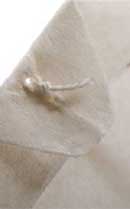
2008:
After several years of development: Sale of first HST tea bag machine with knotted thread instead of metal clamp (on the head folding). It is particularly worth mentioning that most existing HST machines can be retrofitted. This has given the machine customers a high level of investment protection.
Another advantage of this knot is that the bag cannot break off when the thread is pulled, because the knot consists of a self-looping stitch.
2010/2011:
Development of a series of teas with Bach flowers. Stephanie Klar had the idea through her positive experience with the use of Bach flowers in the family.
2013:
A solution for replacement of the metal clip on the tag with a knot is now available. This technology can also be retrofitted to the existing machines.
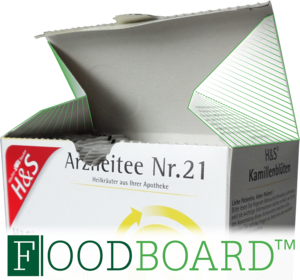
2019:
Development of a high-standard packaging method on the cartoning devices of our teabag machines: Foodboard™ makes the box tighter against contaminants like MOSH/MOAH and the like. This is achieved by a combination of folded flaps in the edges with a special cardboard material Foodboard™ supplied by the Mayr-Melnhof Group. The new system can be retrofitted on all standard cartoning devices of our machinery.
2023:
We look back on 70 years of mechanical engineering. On January 1, 2023, we have spun off the machinery division as an operating company to meet the increasing demands of our customers.
But only the company name has changed to "HST Packing Machines GmbH & Co KG". Our machines run on and on. Hence our motto: Sharing decades together.
Today:
This is what we have been working towards for more than these 70 years: That you become our highly esteemed customer, use our machines, enjoy our tea or let it help to serve your health.

